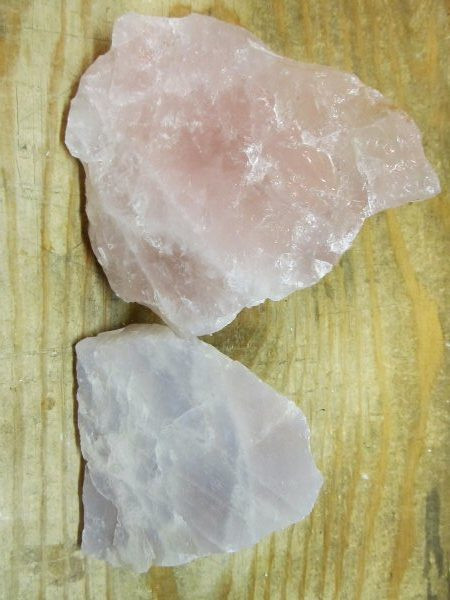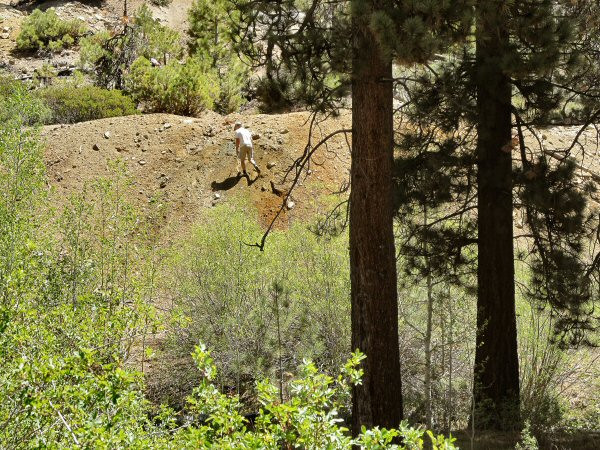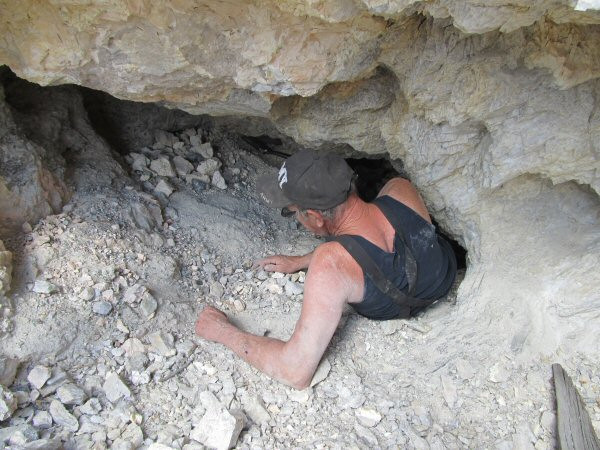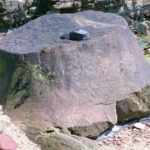How To Get Quartz Out Of Rock? Discovering quartz within rock formations can be an exciting endeavor for geologists, hobbyists, and anyone fascinated by the Earth’s treasures. This guide, brought to you by rockscapes.net, will delve into effective methods for extracting quartz, focusing on techniques applicable in diverse geological settings across the USA and offering insights into the unique quartz varieties found in Arizona and beyond. Whether you’re a seasoned collector or just starting out, understanding the right tools and approaches will help you safely and successfully unearth these beautiful crystals.
1. Understanding Quartz and Its Geological Context
Before diving into extraction techniques, it’s crucial to understand what quartz is and where it’s typically found.
1.1. What is Quartz?
Quartz is a hard, crystalline mineral composed of silicon and oxygen atoms. It’s one of the most abundant minerals in the Earth’s continental crust. According to Arizona State University’s School of Earth and Space Exploration, quartz is a key component of many igneous, metamorphic, and sedimentary rocks.
1.2. Types of Quartz
Quartz comes in a variety of forms, each with its unique properties and appearance:
- Clear Quartz: Pure, transparent quartz.
- Rose Quartz: Pink-colored quartz, often used in jewelry.
- Amethyst: Purple quartz, prized for its color.
- Smoky Quartz: Gray or brown quartz, colored by natural irradiation.
- Citrine: Yellow to orange quartz, often used as a gemstone.
1.3. Geological Formations Where Quartz is Found
Quartz can be found in a variety of geological settings:
- Veins: Quartz often forms in veins within rocks, along with other minerals.
- Pegmatites: These are coarse-grained igneous rocks that can contain large quartz crystals.
- Geodes: Quartz can line the inside of geodes, creating stunning crystal formations.
- Riverbeds and Beaches: Quartz pebbles and sand are common in these environments due to the mineral’s resistance to weathering.
 Rose quartz specimens alongside Brazilian quartz showing the color difference
Rose quartz specimens alongside Brazilian quartz showing the color difference
2. Identifying Quartz in the Field
Being able to identify quartz in its natural environment is the first step to successful extraction.
2.1. Visual Identification
Quartz typically has a glassy or vitreous luster. It can range from transparent to translucent, and its crystal shapes are often hexagonal.
2.2. Hardness Test
Quartz has a hardness of 7 on the Mohs scale, meaning it can scratch glass and steel. This is a reliable way to distinguish it from softer minerals.
2.3. Location Clues
Look for quartz in areas known for mining activity or geological formations that are likely to contain veins and pegmatites. According to the United States Geological Survey (USGS), certain regions are known for specific types of quartz.
3. Essential Tools and Safety Equipment
Having the right tools and safety gear is crucial for safely and effectively extracting quartz from rock.
3.1. Basic Hand Tools
- Geological Hammer: For breaking rocks and exposing quartz veins.
- Chisels: For carefully removing quartz crystals from the surrounding rock.
- Pry Bar: For prying apart larger rocks.
- Shovels and Buckets: For moving debris and collecting samples.
3.2. Power Tools
- Rock Saw: For cutting large rocks into manageable pieces.
- Diamond Blade Saw: For precision cutting of quartz crystals.
- Grinder and Polisher: For cleaning and polishing quartz specimens.
3.3. Safety Equipment
- Safety Glasses: To protect your eyes from flying debris.
- Gloves: To protect your hands from sharp rocks and tools.
- Dust Mask: To prevent inhalation of dust particles.
- Steel-Toed Boots: To protect your feet from falling rocks.
- Hard Hat: To protect your head, especially in mining areas.
3.4. Where to Get Your Equipment
Reliable sources for geological tools and equipment include:
- Geological Supply Stores: These specialized stores offer a wide range of tools and equipment for rockhounding and mineral collecting.
- Online Retailers: Websites like Amazon and eBay offer a variety of geological tools at competitive prices.
- Rock and Mineral Shows: These events are great places to find unique tools and equipment, as well as connect with other collectors and experts.
4. Techniques for Extracting Quartz from Rock
There are several techniques you can use to extract quartz from rock, depending on the type of formation and the tools available.
4.1. Hand Extraction
This method is suitable for smaller quartz veins and crystals that are easily accessible.
- Preparation: Clear away any loose debris from the area around the quartz.
- Chiseling: Use a chisel and geological hammer to carefully remove the rock surrounding the quartz.
- Prying: Gently pry the quartz crystal or vein from the rock matrix.
- Collection: Collect the extracted quartz and any associated minerals.
4.2. Rock Splitting
This technique is used for larger rocks that contain quartz veins or crystals.
- Inspection: Examine the rock to identify natural cracks and weaknesses.
- Wedges: Insert wedges into the cracks and use a geological hammer to drive them in.
- Splitting: Continue driving the wedges until the rock splits along the desired line.
- Extraction: Once the rock is split, extract the quartz crystals or veins.
4.3. Power Tool Extraction
For more challenging extractions, power tools can be invaluable.
- Rock Sawing: Use a rock saw to cut the rock into smaller, more manageable pieces.
- Diamond Blade Cutting: Use a diamond blade saw to precisely cut around the quartz crystals.
- Grinding and Polishing: Use a grinder and polisher to clean and polish the extracted quartz.
 Examining tailings piles for minerals
Examining tailings piles for minerals
4.4. Tips for Minimizing Damage to Quartz
- Gentle Approach: Always use a gentle approach when extracting quartz to avoid damaging the crystals.
- Support: Provide support to the quartz crystal or vein while extracting it to prevent breakage.
- Proper Tools: Use the right tools for the job to minimize the risk of damage.
- Patience: Be patient and take your time to ensure a successful extraction.
5. Ethical and Legal Considerations
When extracting quartz from rock, it’s important to consider ethical and legal guidelines.
5.1. Respecting Private Property
Always obtain permission from landowners before collecting rocks or minerals on their property.
5.2. Following Mining Laws
Be aware of local and federal mining laws and regulations. Some areas may be protected or have restrictions on collecting.
5.3. Environmental Responsibility
Practice responsible rockhounding by minimizing your impact on the environment. Fill in any holes you dig, avoid disturbing vegetation, and pack out all trash.
5.4. Leave No Trace Principles
Adhere to the Leave No Trace principles to preserve the natural beauty of the areas you visit.
6. Specific Locations for Quartz Hunting in the USA
The USA offers numerous locations for quartz hunting, each with its unique geological characteristics.
6.1. Quartz Sites in Arizona
Arizona is renowned for its diverse geology and abundance of quartz.
- Quartzsite: As the name suggests, Quartzsite is a prime location for finding quartz crystals.
- Mazatzal Mountains: This area is known for its amethyst and other quartz varieties.
- White Tank Mountains: Here, you can find clear quartz and smoky quartz.
6.2. Quartz Sites in California
California’s varied geology makes it another great state for quartz hunting.
- Himalaya Mine: Located in San Diego County, this mine is famous for its tourmaline and quartz crystals.
- Mount Ida: This area is known for its quartz crystals, including clear quartz and smoky quartz.
6.3. Quartz Sites in Arkansas
Arkansas is famous for its high-quality quartz crystals.
- Ouachita Mountains: This region is rich in quartz deposits, including clear quartz and milky quartz.
- Ron Coleman Mining: This mine offers opportunities for public crystal digging.
6.4. Other Notable Locations
- North Carolina: Known for its emeralds and quartz.
- Maine: Famous for its tourmaline and quartz crystals in pegmatite formations.
 Checking maps for locations
Checking maps for locations
7. Cleaning and Preserving Your Quartz Finds
Once you’ve extracted your quartz, it’s important to clean and preserve it properly.
7.1. Initial Cleaning
Remove any loose dirt or debris from the quartz using a soft brush and water.
7.2. Soaking
Soak the quartz in a solution of warm water and mild detergent to loosen stubborn dirt.
7.3. Acid Treatment
For more thorough cleaning, you can use a diluted solution of hydrochloric acid or oxalic acid. Always wear gloves and eye protection when working with acids.
7.4. Rinsing and Drying
Rinse the quartz thoroughly with clean water and allow it to air dry.
7.5. Preservation Techniques
- Storage: Store your quartz specimens in a dry, protected environment.
- Display: Display your quartz in a way that showcases its beauty and protects it from damage.
- Labeling: Label your specimens with information about their location and date of discovery.
8. The Fascination of Quartz: Why We Collect It
Quartz has captivated collectors and enthusiasts for centuries. Its beauty, variety, and geological significance make it a rewarding mineral to collect.
8.1. Aesthetic Appeal
Quartz crystals are prized for their aesthetic appeal. Their clarity, color, and unique formations make them beautiful additions to any collection.
8.2. Metaphysical Properties
Many people believe that quartz has metaphysical properties, such as healing and energy amplification. While these beliefs are not scientifically proven, they add to the allure of quartz for many collectors.
8.3. Educational Value
Collecting quartz can be an educational hobby, teaching you about geology, mineralogy, and the Earth’s history.
8.4. Investment Potential
Certain types of quartz, such as amethyst and citrine, can be valuable gemstones. Collecting these specimens can be a rewarding investment.
9. Connecting with the Rockhounding Community
Joining a rockhounding club or connecting with other enthusiasts can enhance your quartz-collecting experience.
9.1. Rockhounding Clubs
Rockhounding clubs offer opportunities to learn from experienced collectors, participate in field trips, and share your discoveries.
9.2. Online Forums and Groups
Online forums and social media groups provide a platform for connecting with other rockhounds, asking questions, and sharing information.
9.3. Rock and Mineral Shows
Rock and mineral shows are great places to meet other collectors, buy and sell specimens, and learn about new discoveries.
10. Exploring Rockscapes.net for More Information
For more information on quartz, rockhounding, and landscape design, visit rockscapes.net.
10.1. Landscape Design Ideas
Rockscapes.net offers a wealth of landscape design ideas using natural stone, including quartz.
10.2. Stone Types and Applications
Learn about different types of stone and their applications in landscaping, including quartz.
10.3. DIY Project Guides
Find step-by-step guides for DIY landscaping projects using natural stone.
10.4. Expert Advice
Get expert advice on choosing the right stones for your landscape and maintaining your stone features.
 Man digging in a quartz mine
Man digging in a quartz mine
11. Latest Trends in Quartz and Landscape Design
Stay updated with the latest trends in quartz and landscape design in the USA.
| Trend | Description |
|---|---|
| Quartz Water Features | Incorporating quartz into waterfalls, fountains, and ponds for a natural, shimmering effect. |
| Quartz Pathways | Using quartz pebbles and slabs to create unique and eye-catching pathways in gardens and yards. |
| Quartz Accent Walls | Adding quartz to outdoor walls for texture and visual interest. |
| Quartz Garden Borders | Using quartz stones to define garden beds and create a natural border. |
| Quartz-Enhanced Fire Pits | Integrating quartz into fire pit designs for a touch of elegance and mystique. |
12. Frequently Asked Questions (FAQs) About Extracting Quartz
12.1. What is the best way to identify quartz in the field?
The best way to identify quartz in the field is by its hardness (7 on the Mohs scale), glassy luster, and hexagonal crystal shapes.
12.2. What tools do I need to extract quartz from rock?
You will need a geological hammer, chisels, a pry bar, safety glasses, gloves, and a dust mask. Power tools like a rock saw and diamond blade saw can also be helpful.
12.3. How can I minimize damage to quartz crystals during extraction?
To minimize damage, use a gentle approach, provide support to the crystal, use the proper tools, and be patient.
12.4. Are there any legal restrictions on collecting quartz in the USA?
Yes, you should always respect private property, follow mining laws, and practice environmental responsibility.
12.5. Where are some good locations for quartz hunting in Arizona?
Good locations in Arizona include Quartzsite, the Mazatzal Mountains, and the White Tank Mountains.
12.6. How do I clean quartz crystals after extraction?
Clean quartz crystals by removing loose debris, soaking them in warm water and mild detergent, and using a diluted acid solution if necessary.
12.7. What are some ethical considerations when collecting quartz?
Ethical considerations include respecting private property, following mining laws, and minimizing your impact on the environment.
12.8. How can I connect with other rockhounding enthusiasts?
You can connect with other enthusiasts by joining rockhounding clubs, participating in online forums, and attending rock and mineral shows.
12.9. What are some popular landscape design ideas using quartz?
Popular landscape design ideas include quartz water features, pathways, accent walls, garden borders, and fire pits.
12.10. Where can I find more information about quartz and landscape design?
You can find more information at rockscapes.net, which offers landscape design ideas, stone types, DIY project guides, and expert advice.
13. Conclusion: The Thrill of Unearthing Earth’s Treasures
Extracting quartz from rock is a rewarding and educational experience that combines the thrill of discovery with the beauty of nature. By understanding the geology of quartz, using the right tools and techniques, and following ethical guidelines, you can safely and successfully unearth these stunning crystals. Whether you’re a seasoned collector or just starting out, the world of quartz offers endless opportunities for exploration and appreciation.
Are you ready to start your own quartz-collecting adventure? Visit rockscapes.net today to explore stunning design ideas, discover unique stone types, and get expert advice on creating your dream landscape. With rockscapes.net, you’ll find everything you need to transform your outdoor space into a breathtaking showcase of natural beauty. Contact us at 1151 S Forest Ave, Tempe, AZ 85281, United States, or call +1 (480) 965-9011. Let rockscapes.net be your guide to the fascinating world of rockhounding and landscape design.

